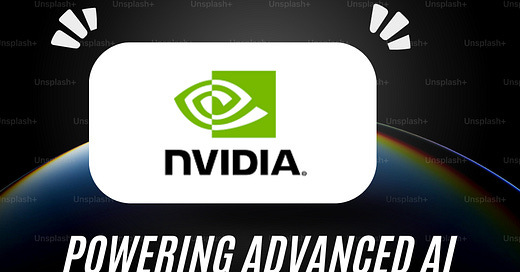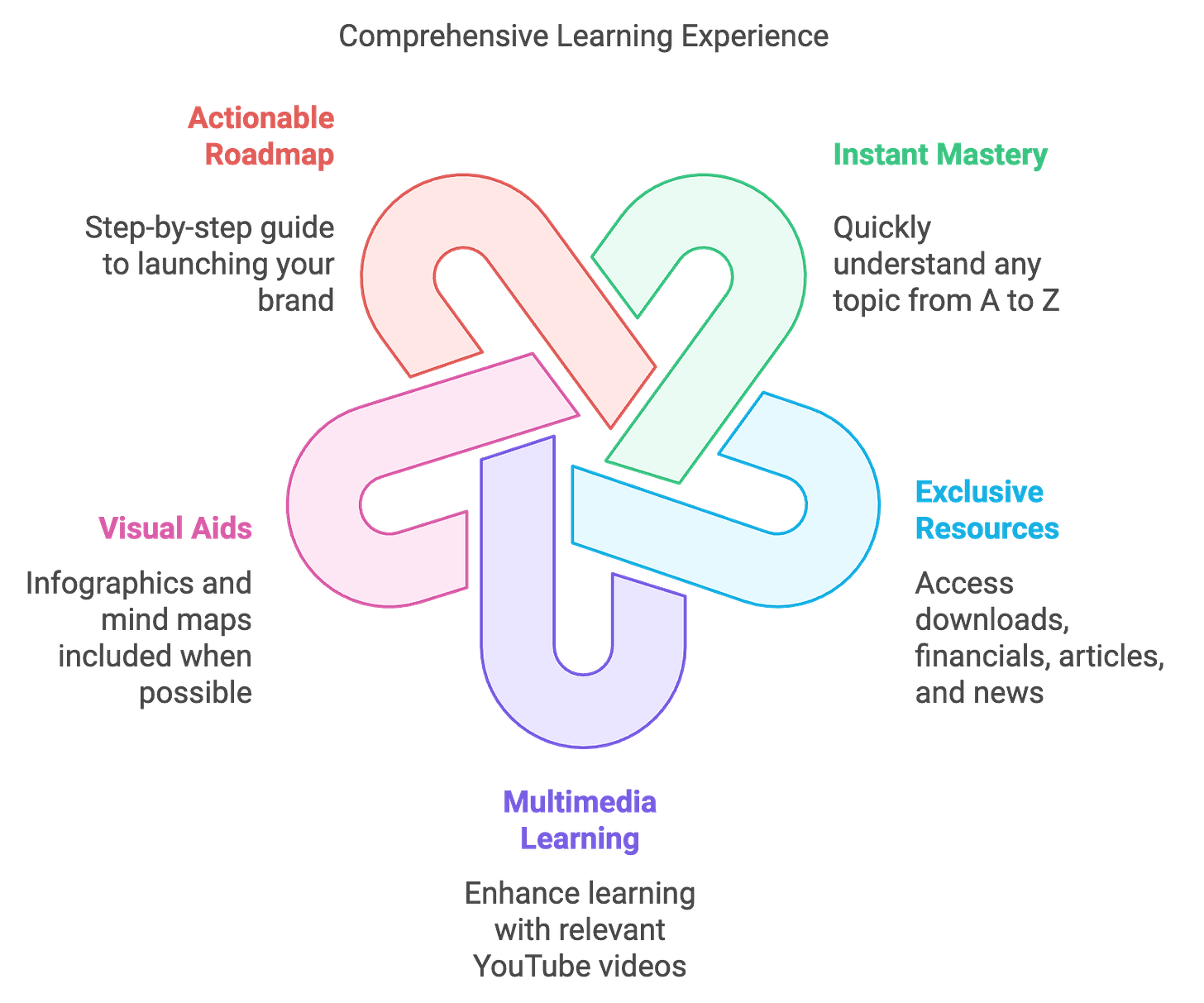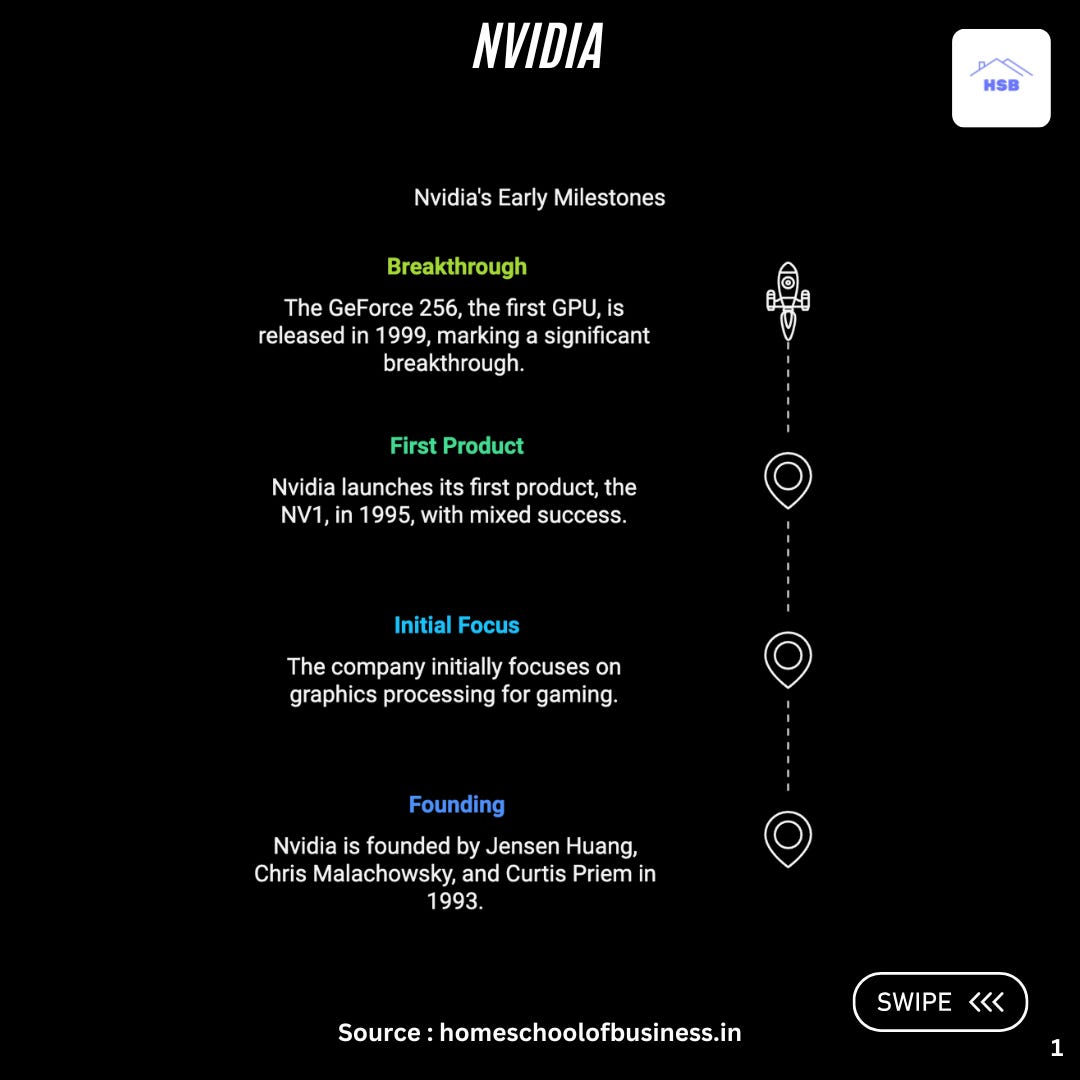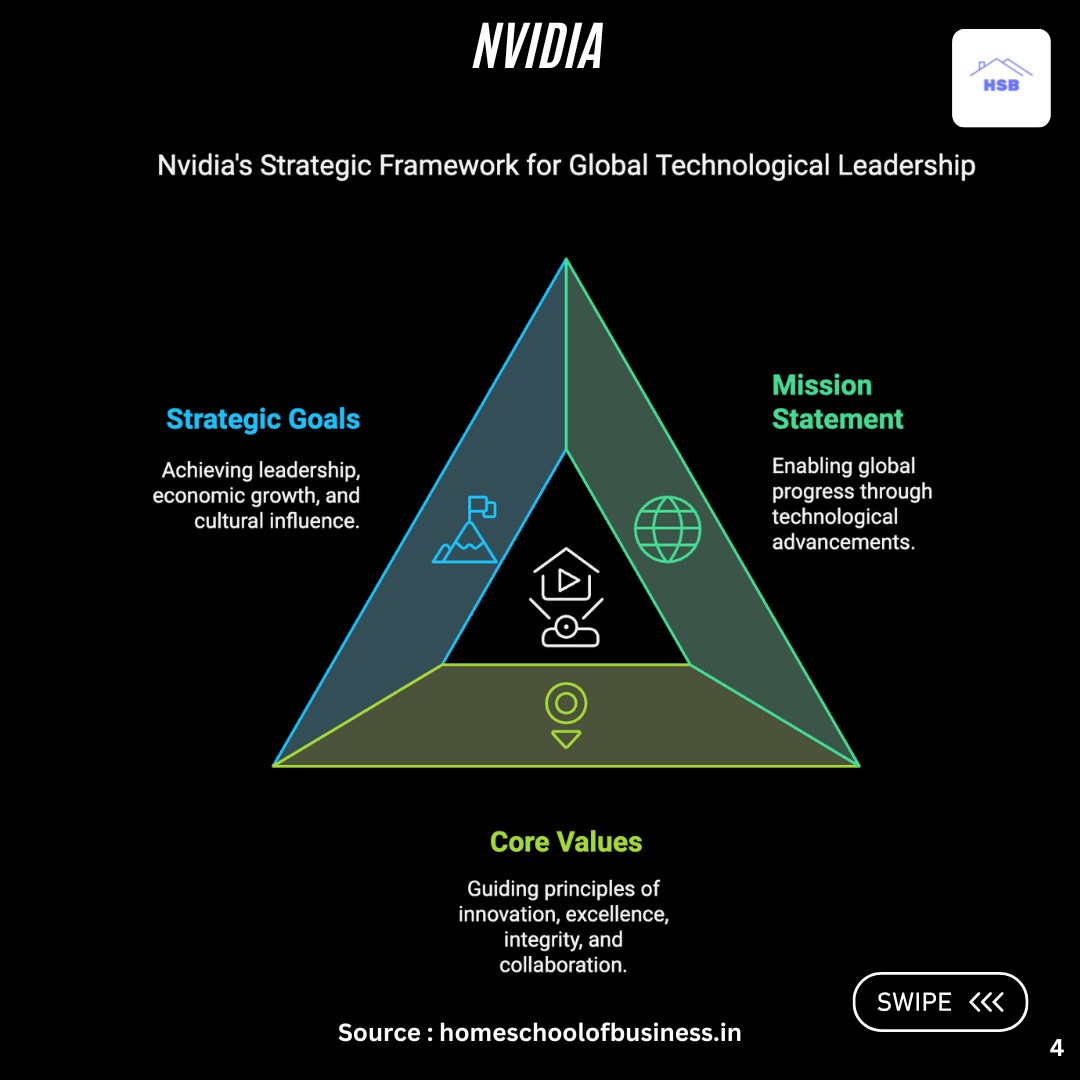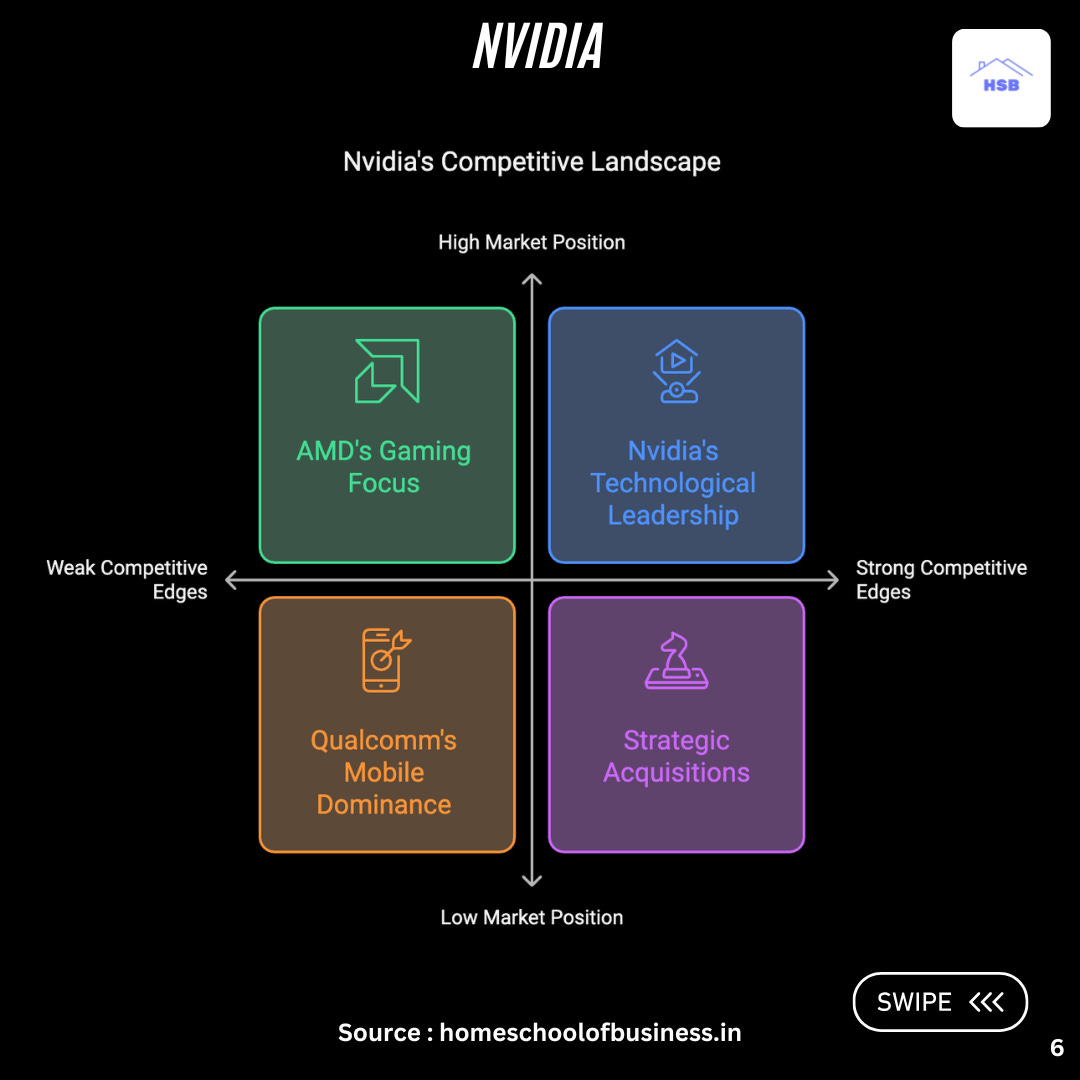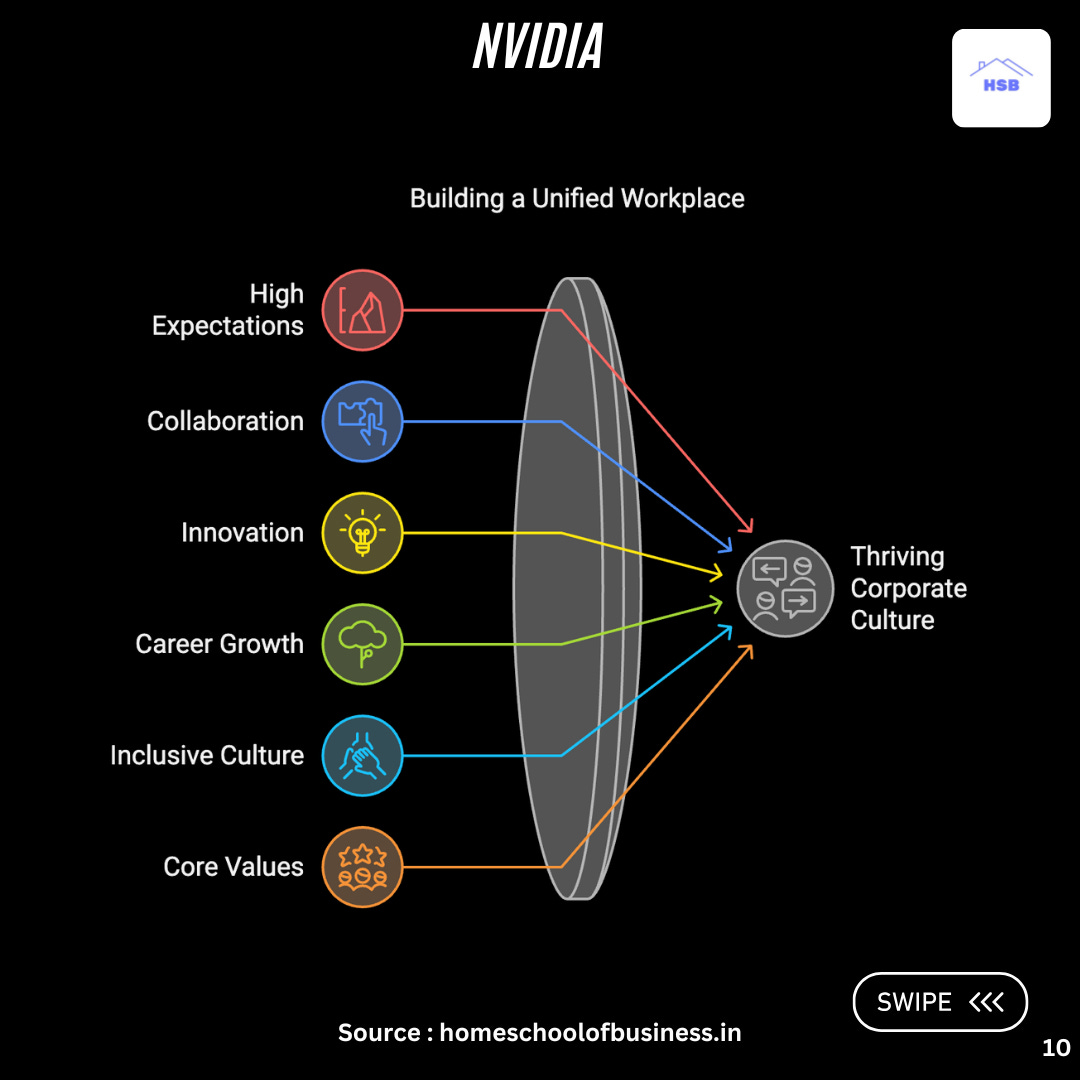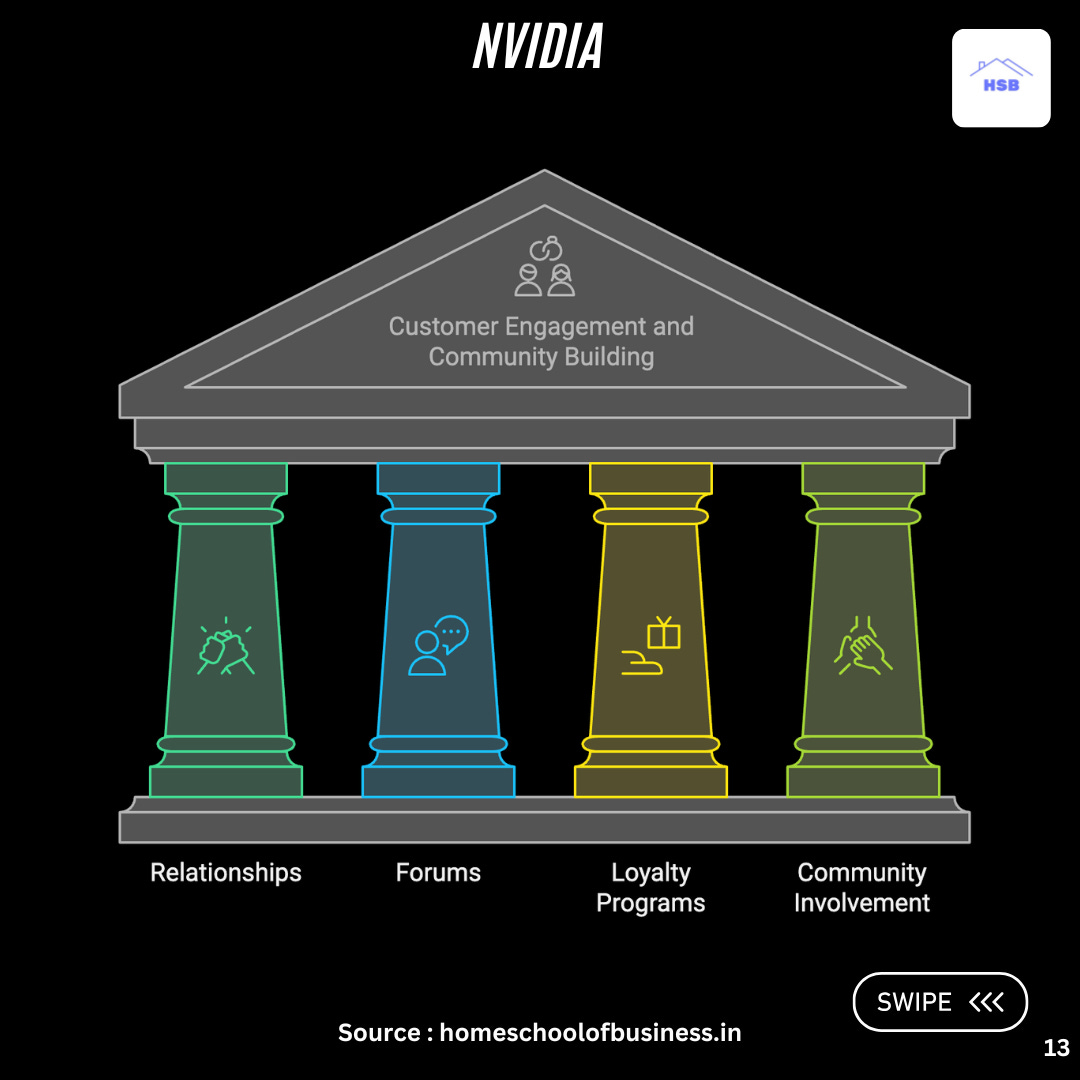Is NVIDIA’s AI Revolution Your Ticket to Next-Level Business Success?
Open now to discover the secret strategies behind a $1T valuation—and how they can supercharge your startup journey!
Welcome to The Home School of Business!
100+ Posts | 16K+ Entrepreneurs
🚀Now Curated for General Public with more Visuals & Infographics.
Our Mission: Unlocking the secrets of businesses, brands, leaders, and more to inspire entrepreneurs everywhere.
The Home School of Business Website
💬Join our WhatsApp Channel (In a hurry ? We’ve packed the highlights of the article right here, paired with the latest Breaking News Headlines every End-of-Day you can’t afford to miss.)
Check out the Quick Summary Insights & Top Weekly News Headlines on our Instagram
✨ Experience Home School of Business Podcasts on Spotify Today!
📲 Tap here to open Spotify and enjoy our latest episodes!
Business Articles We Offer:Powerhouses of Business Series,
Icons of Leadership Series,
City Chronicles Series
Why You'll Love Us:
Nvidia: A Comprehensive Business Journey
In the dynamic and rapidly advancing realm of technology, Nvidia has established itself as a powerhouse in graphics processing, artificial intelligence, and high-performance computing. From its inception as a graphics card manufacturer to becoming a pivotal player in AI and data centers, Nvidia has continuously pushed the boundaries of innovation and influence. This article delves into the extraordinary journey of Nvidia, analyzing its successes and challenges through a business perspective while maintaining an engaging and accessible narrative for the general reader.
Founding Story: From Graphics to Global Leader
Nvidia's origins trace back to 1993 when Jensen Huang, Chris Malachowsky, and Curtis Priem founded the company in Santa Clara, California. Recognizing the burgeoning potential of graphics processing units (GPUs) in the gaming industry, Nvidia set out to revolutionize visual computing.
In 1995, Nvidia introduced its first product, the NV1, a combination of 2D and 3D graphics, audio, and I/O capabilities. Although the NV1 did not achieve commercial success, it laid the groundwork for Nvidia's future innovations. The company's breakthrough came in 1999 with the release of the GeForce 256, heralded as the world's first GPU, which significantly enhanced gaming graphics and performance. This milestone established Nvidia as a key player in the graphics market and set the stage for its continued growth and diversification.
History and Milestones: A Journey of Innovation and Expansion
Nvidia's history is punctuated by significant milestones that underscore its growth, technological advancements, and strategic expansions:
1995: Founding of Nvidia
Established by Jensen Huang, Chris Malachowsky, and Curtis Priem, Nvidia aimed to lead in graphics processing technology.
1999: Launch of GeForce 256
Introduced as the first GPU, it revolutionized graphics performance and established Nvidia's dominance in the gaming industry.
2006: Introduction of CUDA
Launched the Compute Unified Device Architecture (CUDA), enabling GPUs to perform general-purpose computing tasks and expanding their application beyond graphics.
2012: Acquisition of Icera
Entered the mobile computing market by acquiring Icera, a wireless modem chipmaker, diversifying its technological portfolio.
2016: Turing Architecture
Released the Turing architecture, introducing real-time ray tracing and AI-driven features, setting new standards in graphics and computing.
2020: Acquisition of Arm Holdings (Pending)
Announced plans to acquire Arm Holdings, aiming to expand Nvidia's influence in the semiconductor industry and AI.
2023: Launch of Nvidia AI Enterprise
Expanded its AI software suite, catering to businesses seeking to leverage AI for various applications, from data analytics to autonomous systems.
2024: Acquisition of Run:ai
Completed the $700 million acquisition of Israeli AI startup Run:ai, enhancing Nvidia's AI infrastructure capabilities.
2025: Launch of GeForce RTX 50-Series GPUs
Introduced the GeForce RTX 50-series graphics cards, featuring the new Blackwell architecture, offering substantial performance improvements for gaming and AI applications.
2025: Introduction of Project DIGITS
Unveiled Project DIGITS, a $3,000 personal AI supercomputer designed for developers and enthusiasts, enabling advanced AI model training without reliance on cloud infrastructure.
2025: Expansion of AI Partnerships
Announced collaborations with companies like Toyota and Aurora Innovation to advance autonomous vehicle technologies, leveraging Nvidia's AI platforms.
These milestones reflect Nvidia's strategic innovations, market expansions, and ability to stay at the forefront of technological advancements through continuous product evolution and strategic acquisitions.
Rapid Growth: Leadership and Strategic Execution
Nvidia's meteoric rise in the technology sector can be attributed to visionary leadership, strategic partnerships, and relentless innovation. Jensen Huang's leadership, combined with Nvidia's focus on cutting-edge technology and market diversification, has propelled the company to unprecedented heights.
Key Strategies Behind Rapid Growth:
Branding and Image:
Innovation and Excellence:
Emphasizing Nvidia's role as a leader in GPU technology and AI, fostering a brand image synonymous with high performance and reliability.
Thought Leadership:
Positioning Nvidia as an authority in emerging technologies through conferences, publications, and collaborations with academic institutions.
Technological Innovation:
GPU Advancement:
Continuously developing advanced GPUs that set industry standards in performance and efficiency.
AI and Machine Learning:
Investing in AI research and integrating machine learning capabilities into products and services.
Data Center Solutions:
Expanding into data center technologies, providing high-performance computing solutions for enterprises and cloud providers.
Strategic Collaborations:
Industry Partnerships:
Collaborating with major tech companies like Microsoft, Google, and Amazon to integrate Nvidia's technologies into cloud services and platforms.
Academic Alliances:
Partnering with universities and research institutions to drive innovation and foster talent development.
Marketing Excellence:
Targeted Campaigns:
Implementing marketing strategies that highlight Nvidia's technological prowess and application across various industries.
Community Engagement:
Building a strong community of developers, gamers, and enterprise users through forums, events, and support initiatives.
Nvidia's ability to blend technological innovation with strategic execution has been pivotal in its rapid growth, establishing it as a dominant force in the global technology market.
Mission and Vision: Shaping Success and Influence
Nvidia's mission centers around enabling the world to achieve more through cutting-edge technology. The company strives to transform industries and improve lives by delivering high-performance computing solutions that drive innovation and efficiency.
Core Values:
Innovation:
Committing to continuous technological advancement and pioneering new frontiers in computing.
Excellence:
Maintaining the highest standards in product quality, performance, and customer satisfaction.
Integrity:
Upholding ethical practices and transparency in all business operations.
Collaboration:
Fostering a collaborative environment to drive collective success and innovation.
Impact Goals:
Technological Leadership:
Leading the development of transformative technologies in AI, graphics, and computing.
Economic Growth:
Contributing significantly to the global technology economy through product sales, partnerships, and innovation.
Social Impact:
Enhancing education, healthcare, and environmental sustainability through technology-driven solutions.
Cultural Influence:
Shaping digital culture and entertainment through advancements in gaming and virtual reality.
Nvidia's mission and vision encapsulate its dedication to leveraging technology to drive progress, ensuring its lasting impact on both the technology and broader societal landscapes.
Products and Services: Beyond Graphics
While Nvidia is renowned for its GPUs, the company has diversified its offerings to encompass a wide range of products and services that bolster its market presence and consumer appeal.
Flagship Offerings:
Hardware:
GeForce GPUs:
High-performance graphics cards tailored for gaming, offering superior rendering and real-time ray tracing capabilities.
Quadro and RTX Series:
Professional-grade GPUs designed for industries such as design, animation, and engineering, providing unparalleled precision and performance.
Data Center Solutions:
GPUs and networking products optimized for data centers, enabling efficient AI training, data analytics, and high-performance computing.
Nvidia Tegra:
Mobile processors that power devices ranging from smartphones to automotive infotainment systems.
Software:
CUDA:
A parallel computing platform and programming model that allows developers to leverage GPU capabilities for general-purpose computing tasks.
Nvidia AI Enterprise:
An AI software suite that provides tools and frameworks for businesses to implement AI solutions effectively.
Omniverse:
A collaborative platform for 3D content creation and simulation, facilitating real-time collaboration across industries.
Services:
Cloud Gaming (GeForce NOW):
A cloud-based gaming service that allows users to stream games from the cloud, providing high-quality gaming experiences without the need for powerful local hardware.
Autonomous Vehicle Solutions:
Platforms and technologies that support the development and deployment of self-driving vehicles, enhancing safety and efficiency.
Collaborations:
Tech Partnerships:
Collaborating with companies like Microsoft, Google, and Amazon to integrate Nvidia's technologies into cloud services and platforms.
Academic Collaborations:
Partnering with universities and research institutions to drive innovation and support academic research in AI and computing.
Customer Benefits:
Performance and Reliability:
Delivering high-performance products that meet the demanding needs of gamers, professionals, and enterprises.
Innovation and Future-Proofing:
Providing cutting-edge technologies that anticipate and meet future market trends and consumer demands.
Comprehensive Ecosystem:
Offering a holistic suite of hardware, software, and services that cater to a diverse range of applications and industries.
Nvidia's extensive product and service portfolio ensures that it addresses the needs of various market segments, from individual consumers to large enterprises, maintaining its relevance and appeal across different industries.
Market Position and Competition: Leading with Influence
In the fiercely competitive technology landscape, Nvidia has carved out a unique market position through its distinctive branding, technological leadership, and strategic integrations.
Industry Standing:
Top Technology Companies:
Competitors:
AMD, Intel, Qualcomm, and other prominent technology firms.
Competitive Edge:
Nvidia's strong association with high-performance GPUs, AI technologies, and data center solutions sets it apart from competitors.
AI and Machine Learning:
Competitors:
Google (TPU), Amazon (AWS Inferentia), and other AI-focused technology providers.
Competitive Edge:
Nvidia's comprehensive AI ecosystem, including CUDA, AI frameworks, and dedicated hardware like the Tensor Core, provides a robust platform for AI development and deployment.
Gaming Industry:
Competitors:
AMD Radeon, Intel Arc, and other gaming hardware manufacturers.
Competitive Edge:
GeForce GPUs' superior performance, real-time ray tracing, and strong developer support enhance Nvidia's dominance in the gaming market.
Competitive Edge:
Technological Leadership:
Pioneering advancements in GPU technology, AI, and high-performance computing ensures Nvidia remains at the forefront of innovation.
Comprehensive Ecosystem:
Offering an integrated suite of hardware, software, and services provides a seamless experience for developers, gamers, and enterprises.
Brand Reputation:
Established as a trusted and reliable brand, Nvidia benefits from strong consumer loyalty and recognition.
Strategic Acquisitions:
Acquiring key companies and technologies, such as Mellanox and potential Arm Holdings acquisition, expands Nvidia's capabilities and market reach.
Nvidia's ability to maintain a leading market position amidst intense competition underscores its strategic prowess and enduring technological strength.
Business Model: The Nvidia Ecosystem
Nvidia operates within a multifaceted business framework, leveraging its technological innovations and strategic partnerships to create a robust and diversified revenue model. The business model emphasizes product innovation, strategic marketing, and ecosystem integration.
Core Services:
Product Development:
Designing and manufacturing high-performance GPUs, AI hardware, and other computing solutions.
Software and Platforms:
Developing software tools, AI frameworks, and collaborative platforms that enhance hardware capabilities and user experiences.
Marketing and Branding:
Creating impactful advertising campaigns, fostering community engagement, and maintaining a strong brand presence through endorsements and partnerships.
Retail and Distribution:
Utilizing a global distribution network to ensure widespread availability of products through retail stores, online platforms, and enterprise sales channels.
Community Engagement:
Building a loyal community of developers, gamers, and enterprise users through forums, events, and support initiatives.
Exclusive Product Range:
Signature Products:
GeForce Series:
Ongoing releases of new GPU models that build on the legacy of previous editions, offering enhanced performance and features.
Nvidia RTX:
GPUs equipped with real-time ray tracing and AI-driven capabilities, catering to high-end gaming and professional applications.
Collaborative Editions:
Partner Designs:
Unique GPU designs developed in partnership with other technology firms and industry leaders.
Special Editions:
Limited-edition releases that feature exclusive designs and enhanced specifications for niche markets.
Revenue Streams:
Product Sales:
Revenue from selling GPUs, AI hardware, and other computing solutions across various models and editions.
Software and Services:
Income from licensing software platforms, AI frameworks, and cloud-based services like GeForce NOW.
Data Center Solutions:
Earnings from providing high-performance computing solutions to enterprises, cloud providers, and research institutions.
Collaborations and Licensing:
Revenue from partnerships, licensing technologies, and joint ventures with other companies.
E-commerce and Direct Sales:
Online sales through Nvidia’s official website and direct retail channels, catering to both individual consumers and enterprises.
Target Market:
Gamers and Enthusiasts:
Individuals seeking high-performance gaming hardware and immersive gaming experiences.
Professionals and Creators:
Designers, animators, engineers, and other professionals requiring reliable and powerful computing solutions.
Enterprises and Data Centers:
Businesses and institutions leveraging high-performance computing for AI, data analytics, and research.
AI and Machine Learning Developers:
Developers and researchers utilizing Nvidia's AI platforms and tools for developing advanced AI applications.
Nvidia's comprehensive business model, encompassing diverse revenue streams and a wide target market, ensures sustained growth and market dominance across multiple technology sectors.
Financial Analysis of Nvidia
Nvidia has consistently showcased strong financial performance, contributing significantly to the technology industry's growth. The company's strategic investments in product development, marketing, and global expansion underpin its financial success.
Financial Performance:
Revenue (Fiscal Year 2025): Projected to be approximately $126.5 billion
Insight: This projection reflects a significant increase from the previous year, underscoring Nvidia's successful expansion in AI and data center markets.
Growth Drivers:
AI and Data Center Expansion: Nvidia's data center revenue reached a record $30.8 billion in Q3 FY2025, up 112% year-over-year, highlighting the company's leadership in AI infrastructure.
Innovative Product Launches: The introduction of the Blackwell AI processor and GeForce RTX 50-series GPUs has propelled Nvidia's growth, catering to the increasing demand for high-performance computing solutions.
Strategic Partnerships: Collaborations with industry leaders, such as Toyota and Aurora, have expanded Nvidia's reach into autonomous vehicles and robotics, further diversifying its revenue streams.
These factors collectively contribute to Nvidia's robust financial performance and market leadership in the technology sector.
Investment Highlights:
Product Innovation:
Research and Development (R&D) Expenditure: Nvidia's R&D spending has seen a substantial increase over the years. In fiscal year 2024, the company invested $8.68 billion in R&D, up from $7.34 billion in 2023. This upward trend underscores Nvidia's commitment to enhancing GPU performance, AI capabilities, and expanding its product lines.
Marketing and Branding:
Strategic Marketing Initiatives: Nvidia employs a comprehensive marketing strategy that includes innovation, strategic partnerships, and customer-centric approaches. While specific figures for marketing expenditure are not publicly disclosed, the company's efforts in these areas have been instrumental in achieving significant milestones, such as surpassing Microsoft to become the company with the world's highest market capitalization of $3.34 trillion as of June 18, 2024.
Global Expansion:
Capital Expenditures: Nvidia's capital expenditures have increased significantly, reflecting its efforts to expand its global presence. For the period ending October 27, 2024, capital expenditures were $813 million, a 192.45% increase from the same period last year. This investment supports the expansion of retail and enterprise operations in emerging markets to capture new consumer bases.
These strategic investments highlight Nvidia's dedication to innovation, market presence, and global growth, reinforcing its position as a leader in the technology sector.
Profitability:
Net Profit Margin: 55.69%
Insight: Nvidia's net profit margin has significantly increased, driven by high demand for AI and data center solutions, enabling premium pricing and efficient cost management.
Gross Profit Margin: 75.86%
Insight: The company's gross profit margin has reached new heights, attributed to effective cost control and the high value of its AI and data center offerings.
These figures underscore Nvidia's exceptional profitability, setting new industry benchmarks.
Revenue Streams:
Data Center Solutions: 78%
Revenue from providing high-performance computing solutions to enterprises and research institutions, primarily driven by AI and cloud computing demands.
Gaming Products: 17%
Income from selling GPUs and related hardware for gaming applications.
Professional Visualization: 2.5%
Earnings from advanced graphics solutions for professionals in design, animation, and visualization.
Automotive Solutions: 1.8%
Revenue from AI-driven automotive technologies, including autonomous vehicle systems and infotainment platforms.
OEM and Other: 0.5%
Income from original equipment manufacturer (OEM) partnerships and other miscellaneous sources.
Cost Structure:
Cost of Goods Sold (COGS): Approximately 24% of revenue
Production Costs: Manufacturing and material expenses for GPUs and other hardware.
Logistics: Distribution and transportation costs.
Insight: Nvidia's COGS for the twelve months ending October 31, 2024, was $27.342 billion, a 102.13% increase year-over-year, indicating significant scaling in production to meet demand.
Operating Expenses: Approximately 32% of revenue
Research and Development (R&D): $11.666 billion for the twelve months ending October 31, 2024, a 42.95% increase year-over-year, underscoring a commitment to innovation.
Selling, General, and Administrative (SG&A): $3.23 billion as of September 29, 2024, reflecting investments in marketing, administrative functions, and retail operations.
Insight: The increase in operating expenses aligns with Nvidia's strategic investments in R&D and market expansion, supporting its leadership in AI and high-performance computing.
These figures highlight Nvidia's dynamic cost structure, balancing production scaling with strategic investments to sustain growth and innovation.
Profitability Metrics:
Return on Equity (ROE): 127.21%
Insight: This exceptionally high ROE indicates that Nvidia is generating substantial profits relative to shareholders' equity, demonstrating efficient use of investor funds to drive growth.
Return on Assets (ROA): 59.13%
Insight: A robust ROA signifies that Nvidia is effectively utilizing its assets to produce income, highlighting operational efficiency.
Key Financial Ratios:
Current Ratio: 4.10
Insight: A current ratio of 4.10 reflects a strong liquidity position, indicating that Nvidia has ample short-term assets to cover its short-term liabilities.
Debt-to-Equity Ratio: 0.13
Insight: A low debt-to-equity ratio of 0.13 suggests that Nvidia maintains minimal financial leverage, with manageable debt levels contributing to financial stability.
Trend Analysis:
Revenue Growth:
Recent Performance: In the third quarter of fiscal year 2025, Nvidia reported revenue of $35.1 billion, marking a 94% increase from the same period a year ago.
Insight: This substantial growth is primarily driven by the surging demand for AI and data center solutions, positioning Nvidia at the forefront of technological innovation.
Profit Margins:
Gross Profit Margin: Nvidia's gross margin reached 72.7% in fiscal year 2024, the highest level ever recorded.
Operating Margin: The operating margin also reached a record figure of 54.1% in fiscal year 2024.
Insight: The improvement in profit margins is attributed to Nvidia's focus on high-margin AI and data center products, along with effective cost management strategies.
Capital Expenditures (CapEx):
Recent Investments: In the third quarter of fiscal year 2025, Nvidia reported capital expenditures of $813 million, reflecting ongoing investments in infrastructure to support AI and data center growth.
Insight: These investments are crucial for expanding Nvidia's manufacturing capabilities and R&D centers, ensuring the company meets the growing demand for its products.
Dividend Growth:
Current Status: Nvidia has maintained a consistent dividend payout, with a current dividend yield of approximately 0.05%.
Insight: While the dividend yield remains modest, Nvidia's robust financial performance and substantial free cash flow provide the potential for future dividend increases, enhancing shareholder returns.
These trends underscore Nvidia's strategic focus on high-growth areas, effective cost management, and commitment to delivering value to shareholders.
Comparison with Competitors:
Annual Revenue:
Nvidia: Approximately $113.3 billion for the trailing twelve months ending October 27, 2024.
AMD: Approximately $24.3 billion for the trailing twelve months ending September 28, 2024.
Intel: Approximately $54.2 billion for the trailing twelve months ending September 28, 2024.
Profit Margins (Gross Profit Margin):
Nvidia: 75.86% for the trailing twelve months ending October 27, 2024.
AMD: 48.38% for the trailing twelve months ending September 28, 2024.
Intel: 34.67% for the trailing twelve months ending September 28, 2024.
Financial Challenges and Risks:
Market Volatility:
Impact: Economic downturns can affect consumer and enterprise spending on premium technology products.
Regulatory Risks:
Impact: Changes in trade policies, tariffs, and data privacy laws can impact production costs and operational compliance.
Brand Reputation:
Impact: Any controversies or missteps in product releases can negatively influence consumer perceptions and sales.
Supply Chain Disruptions:
Impact: Global supply chain issues, such as component shortages and increased costs, can hinder product availability and profitability.
Future Financial Prospects:
Revenue Growth:
Projection: Continued expansion in AI, data centers, and gaming markets expected to drive 15-20% annual growth.
Profitability Enhancements:
Strategies: Cost optimizations, premium product offerings, and strategic collaborations to enhance margins.
Investment Focus:
Areas: Digital transformation, sustainable product development, and expanding data center infrastructure.
Shareholder Returns:
Commitment: Sustained revenue growth and profitability will continue to support Nvidia's dividend policies and share value appreciation.
Summary of Financial Health:
Nvidia exhibits robust financial performance characterized by steady revenue growth, healthy profit margins, and efficient resource utilization. Strategic investments in innovation, marketing, and global expansion ensure the company's sustained financial health and competitive advantage in the technology market.
Leadership and Management: Visionary Guidance
Nvidia's success is propelled by a combination of visionary leadership, strategic management, and a profound understanding of market dynamics. Jensen Huang's leadership, alongside a dedicated executive team, has been instrumental in steering the company toward its iconic status.
Key Figures:
Jensen Huang (Founder, President, and CEO):
Jensen Huang co-founded Nvidia in 1993 and has been instrumental in steering the company to its current position as a leader in AI and accelerated computing. His visionary leadership has been pivotal in Nvidia's growth and technological advancements.
Colette Kress (Executive Vice President and Chief Financial Officer):
Colette Kress oversees Nvidia's financial strategies, ensuring robust financial health and strategic investments. She plays a crucial role in managing the company's financial operations and investor relations.
Jay Puri (Executive Vice President of Worldwide Field Operations):
Jay Puri leads Nvidia's global business operations, overseeing sales, business development, partner alliances, solution architecture and engineering, program management, and support services. His leadership has been essential in expanding Nvidia's market presence.
Debora Shoquist (Executive Vice President of Operations):
Debora Shoquist manages Nvidia's operations, focusing on operational efficiencies and the scalability of the company's business. Her role is critical in ensuring that Nvidia's operations align with its strategic objectives.
Tim Teter (Executive Vice President, General Counsel, and Secretary):
Tim Teter oversees Nvidia's legal affairs, providing guidance on legal matters and corporate governance. He joined Nvidia in 2017 after a distinguished career in legal practice, bringing extensive experience in patent and technology-related matters.
This leadership team continues to drive Nvidia's success through strategic vision and operational excellence.
Strategic Decisions:
Technological Innovation:
Investing heavily in R&D to develop advanced GPU architectures, AI frameworks, and high-performance computing solutions.
Strategic Acquisitions:
Acquiring key companies like Mellanox and potential Arm Holdings acquisition to expand technological capabilities and market reach.
Market Diversification:
Expanding beyond gaming into AI, data centers, autonomous vehicles, and professional visualization markets.
Sustainability Initiatives:
Implementing eco-friendly manufacturing processes and sustainable product development to align with global sustainability trends.
Management Practices:
Collaborative Leadership:
Fostering a collaborative environment where innovation and cross-functional teamwork are encouraged to drive creative solutions and efficient project execution.
Data-Driven Decision Making:
Utilizing consumer data, market research, and analytics to inform strategic decisions and optimize marketing strategies.
Agile Management:
Adapting quickly to market changes and technological advancements to maintain competitive edge and responsiveness.
Leadership Impact:
Nvidia's leadership has been crucial in maintaining the company's relevance and appeal. By balancing innovation with strategic growth, the leadership team ensures that Nvidia evolves with changing market preferences while honoring its technological heritage.
Corporate Culture and Employee Insights: Fostering Innovation and Excellence
Nvidia's corporate culture emphasizes innovation, excellence, and a deep commitment to the company's legacy. This culture fosters a motivated and creative workforce dedicated to maintaining Nvidia's iconic status.
Work Environment:
High Expectations:
Employees are encouraged to uphold the highest standards of quality, innovation, and performance in all aspects of their work.
Collaborative Atmosphere:
Promoting teamwork and cross-functional collaboration to drive creative solutions and efficient project execution.
Innovation Encouraged:
A culture that values and rewards creative ideas and continuous improvement ensures Nvidia stays ahead of market trends.
Employee Development:
Training Programs:
Comprehensive training initiatives to develop skills in design, engineering, marketing, and product development.
Career Growth Opportunities:
Clear pathways for advancement within the organization, fostering employee loyalty and retention.
Inclusive Culture:
Promoting diversity and inclusion to harness a wide range of perspectives and ideas, enhancing creativity and problem-solving.
Corporate Values:
Integrity:
Upholding ethical standards in all business practices, ensuring trust and reliability.
Excellence:
Striving for the highest levels of quality and performance in every product and service.
Innovation:
Continuously seeking new ways to improve and differentiate the brand through technological advancements.
Community Engagement:
Encouraging employees to participate in community initiatives and philanthropic efforts, fostering a culture of giving back.
Corporate Culture Insights:
Nvidia's corporate culture not only drives business success but also creates a positive and dynamic workplace where employees are empowered to contribute to the company's ongoing legacy. By fostering an environment that values innovation, collaboration, and excellence, Nvidia attracts and retains top talent, ensuring sustained growth and market leadership.
Innovation and Research & Development: Driving the Future of Technology
Innovation is at the core of Nvidia's business strategy, driving the future of graphics processing, artificial intelligence, and high-performance computing through continuous improvement and technological advancements.
Technological Advancements:
GPU Technology:
Development of advanced GPU architectures like Ampere and Hopper, offering enhanced performance, efficiency, and scalability.
Artificial Intelligence:
Investing in AI research and developing frameworks like CUDA and TensorRT to enable robust AI applications and solutions.
Data Center Innovations:
Creating high-performance computing solutions tailored for data centers, supporting AI training, data analytics, and cloud computing.
Autonomous Vehicle Technology:
Developing platforms like Nvidia DRIVE, which provide the computing power and AI capabilities necessary for self-driving vehicles.
Design Innovations:
Real-Time Ray Tracing:
Implementing real-time ray tracing in GPUs, enhancing visual realism and rendering capabilities for gaming and professional applications.
AI-Driven Features:
Integrating AI-driven features like DLSS (Deep Learning Super Sampling) to improve performance and image quality in gaming and visualization.
Energy Efficiency:
Designing GPUs and computing solutions that offer high performance while minimizing energy consumption, aligning with sustainability goals.
Future Projects:
Quantum Computing Integration:
Exploring the integration of quantum computing technologies to further enhance computational capabilities and solve complex problems.
Advanced AI Frameworks:
Developing next-generation AI frameworks and tools to support more sophisticated and efficient AI applications.
Sustainable Technology Initiatives:
Expanding the use of eco-friendly materials and sustainable manufacturing processes to reduce environmental impact.
Research & Development Focus:
Nvidia's commitment to R&D ensures that the company remains at the forefront of technological innovation. By investing in cutting-edge research, Nvidia not only enhances its product offerings but also drives industry standards and advancements in various technology sectors.
Social Responsibility and Sustainability: Committed to Positive Impact
Nvidia integrates social responsibility and sustainability into its business model, striving to make a positive impact on society and the environment through ethical practices and community initiatives.
CSR Initiatives:
Nvidia Foundation:
Supporting education, research, and community programs that foster innovation and technological advancement.
Community Outreach:
Engaging in programs that promote STEM education, digital literacy, and technological empowerment in underserved communities.
Philanthropic Efforts:
Donations to educational institutions, research projects, and disaster relief efforts, enhancing Nvidia's role as a responsible corporate citizen.
Employee Volunteer Programs:
Encouraging employees to participate in volunteer activities and community service projects, fostering a culture of giving back.
Sustainability Practices:
Eco-Friendly Materials:
Utilizing recycled materials and sustainable components in product manufacturing to minimize environmental impact.
Sustainable Sourcing:
Ensuring responsible sourcing of materials to reduce the environmental footprint and promote ethical supply chain practices.
Green Manufacturing:
Implementing energy-efficient processes and renewable energy sources in manufacturing facilities to lower carbon emissions.
Waste Reduction:
Adopting practices to reduce waste, such as recycling programs, minimal packaging designs, and circular economy initiatives.
Sustainable Packaging:
Developing packaging solutions that are recyclable and environmentally friendly, reducing reliance on single-use plastics.
Environmental Impact Goals:
Carbon Neutrality:
Aiming to achieve carbon neutrality through energy-efficient practices, renewable energy adoption, and carbon offset initiatives.
Water Conservation:
Implementing water-saving technologies in manufacturing processes to reduce water usage and promote sustainability.
Circular Economy:
Promoting the recycling and reuse of products to minimize waste and extend product lifecycle, contributing to a sustainable future.
Nvidia's dedication to social responsibility and sustainability reflects its commitment to ethical business practices and contributing positively to the global community and environment. By integrating these principles into its operations, Nvidia not only enhances its corporate reputation but also ensures long-term sustainability and societal impact.
Customer Engagement and Community Building: Building Lasting Relationships
Nvidia prioritizes building strong relationships with customers and communities through personalized interactions and active engagement, fostering loyalty and sustained brand affinity.
Customer Relationships:
Personalized Experiences:
Offering customization options for GPUs and gaming setups, allowing customers to personalize their hardware to meet specific needs and preferences.
Exclusive Access:
Providing early access to new product releases, special events, and beta programs for loyal customers and community members.
Feedback Mechanisms:
Actively seeking customer feedback through surveys, reviews, and community forums to improve products and services based on user input.
Community Forums:
Nvidia Developer Forums:
Creating platforms for developers to share ideas, collaborate on projects, and access resources, fostering a strong developer community.
GeForce Communities:
Building online communities for gamers to share experiences, tips, and engage in discussions, enhancing the overall gaming experience.
Loyalty Programs:
Nvidia Rewards:
Implementing reward systems that offer points for purchases, engagement, and participation in community activities, encouraging long-term loyalty.
Membership Benefits:
Providing exclusive benefits such as discounts, special content, and early access to new technologies for members of loyalty programs.
Community Involvement:
Local Partnerships:
Collaborating with local businesses, educational institutions, and organizations to support community initiatives and economic growth.
Events and Sponsorships:
Hosting and sponsoring gaming tournaments, tech conferences, and cultural events to engage with communities and promote brand visibility.
Philanthropic Efforts:
Contributing to local and global causes that align with Nvidia’s values, such as education, technology accessibility, and environmental sustainability.
Volunteer Programs:
Encouraging employees and customers to participate in volunteer activities, fostering a culture of community service and social responsibility.
Event Sponsorships:
Gaming Events:
Sponsoring major gaming tournaments, eSports leagues, and gaming conventions to promote Nvidia's gaming hardware and engage with the gaming community.
Tech Conferences:
Participating in and sponsoring technology conferences and seminars to showcase Nvidia's latest innovations and connect with industry leaders.
Cultural Events:
Engaging in music festivals, art exhibitions, and other cultural events to integrate Nvidia into various cultural spheres and reach diverse audiences.
Nvidia's commitment to customer engagement and community building strengthens its reputation and fosters loyalty among customers and local communities. By creating personalized experiences, actively seeking feedback, and participating in community initiatives, Nvidia ensures sustained brand affinity and support, driving long-term success and market presence.
Challenges and Opportunities: Navigating a Dynamic Market
Despite its remarkable successes, Nvidia faces several challenges and opportunities as it continues to expand and innovate in a dynamic and competitive market environment.
Current Challenges:
Market Volatility:
Impact: Economic downturns can reduce consumer and enterprise spending on premium technology products, affecting sales and revenue.
Regulatory Environment:
Impact: Changes in trade policies, tariffs, and data privacy laws can increase production costs, complicate global operations, and limit market access.
Brand Reputation:
Impact: Any controversies, product delays, or missteps in releases can negatively influence consumer perceptions and sales, potentially eroding brand trust.
Supply Chain Disruptions:
Impact: Global supply chain issues, such as component shortages, increased costs, and transportation delays, can hinder product availability and profitability.
Intense Competition:
Impact: The rise of other GPU manufacturers, AI technology providers, and high-performance computing firms intensifies competition for market share and consumer attention.
Future Opportunities:
Global Expansion:
Potential: Entering emerging markets with high growth potential, such as Asia and Africa, to increase market presence and sales, capitalizing on the growing demand for technology products.
Technological Integration:
Potential: Adopting advanced technologies like augmented reality (AR), virtual reality (VR), and blockchain for product authentication to enhance customer experiences and create new market opportunities.
Sustainability Initiatives:
Potential: Increasing focus on sustainable product lines and eco-friendly practices to attract environmentally conscious consumers, reduce operational costs, and comply with regulatory requirements.
Diversification:
Potential: Exploring new business verticals, such as smart home devices, health technology, and autonomous systems, to diversify revenue streams and reduce dependency on traditional GPU sales.
E-commerce Growth:
Potential: Expanding online sales channels and enhancing digital marketing strategies to capture a larger share of the growing e-commerce market, reaching a broader global audience.
Strategic Adjustments:
Innovation Hubs:
Action: Establishing dedicated teams and centers focused on researching and developing new technologies, fostering localized innovation, and responding to regional consumer preferences.
Collaborative Partnerships:
Action: Partnering with technology firms, designers, and sustainability experts to drive innovation, enhance product offerings, and explore new market opportunities.
Consumer Engagement:
Action: Utilizing data analytics and consumer insights to inform product development and marketing strategies, ensuring alignment with market trends and preferences.
Supply Chain Resilience:
Action: Diversifying suppliers, investing in supply chain technologies, and implementing risk management strategies to mitigate the impact of supply chain disruptions.
By addressing these challenges and capitalizing on emerging opportunities, Nvidia can continue to thrive in a competitive and evolving market landscape, maintaining its leadership position and driving sustained growth and innovation.
Future Plans and Strategic Vision: Shaping the Future of Technology and Beyond
Nvidia's strategic vision focuses on sustained growth, technological innovation, and expanding its offerings to meet evolving customer needs and market trends. The company aims to maintain its leadership in GPU technology while exploring new frontiers in AI, data centers, and beyond.
Growth Strategies:
Scaling Operations:
Expansion:
Increasing production capacity and expanding manufacturing facilities to meet growing global demand for GPUs, AI hardware, and high-performance computing solutions.
Distribution:
Enhancing distribution networks to ensure timely delivery and product availability worldwide, optimizing supply chain logistics and partnerships.
Entering New Markets:
Geographic Expansion:
Targeting emerging markets with high growth potential to capture new customer bases, leveraging local partnerships and tailored marketing strategies.
Product Lines:
Introducing new product lines tailored to regional preferences and technological needs, adapting offerings to diverse market demands.
Diversifying Offerings:
Smart Footwear and Devices:
Exploring the development of smart devices and wearable technology, integrating Nvidia's AI and computing capabilities into new product categories.
Premium Collections:
Launching high-end collections with exclusive materials and designs to cater to luxury consumers and niche markets, enhancing brand prestige.
Long-Term Goals:
Global Leadership:
Objective:
Establishing Nvidia as the leading global brand in GPU technology, AI, and high-performance computing, setting industry standards and driving technological advancements.
Sustainable Growth:
Objective:
Achieving sustainable and ethical growth through eco-friendly practices, responsible business operations, and continuous innovation, ensuring long-term viability and societal impact.
Innovative Solutions:
Objective:
Continuously developing innovative products and solutions that enhance performance, efficiency, and user satisfaction, staying ahead of market trends and technological advancements.
Legacy Building:
Objective:
Creating a lasting legacy through impactful projects, community initiatives, and contributions to technology and society, solidifying Nvidia's role as a transformative and responsible corporate leader.
Strategic Initiatives:
Sustainability Projects:
Initiative:
Investing in renewable energy sources, sustainable materials, and eco-friendly manufacturing processes to minimize environmental impact and promote sustainability.
Digital Transformation:
Initiative:
Enhancing digital platforms, e-commerce capabilities, and online services to improve customer experiences, streamline operations, and expand market reach.
Collaborative Innovations:
Initiative:
Partnering with technology firms, research institutions, and industry leaders to create groundbreaking products, technologies, and experiences, fostering innovation and market differentiation.
Nvidia's long-term vision encompasses a future where the company seamlessly integrates technological excellence, sustainability, and global leadership. By focusing on these strategic initiatives, Nvidia aims to continue inspiring and leading in the technology and innovation landscapes, driving progress and shaping the future of various industries.
Building a Similar Brand: Roadmap for Aspiring Entrepreneurs
For those inspired by Nvidia's success and aiming to build a similar technology brand, the following roadmap outlines key steps and strategies essential for creating a thriving and impactful business.
Develop a Clear Mission and Vision:
Define Core Purpose:
Establish the fundamental purpose and values of your business, aligning with technological innovation and market needs.
Set Long-Term Goals:
Align your long-term objectives with your mission to guide strategic decisions and ensure sustained growth and relevance.
Focus on Quality and Consistency:
High-Quality Offerings:
Ensure your products and services meet high standards of quality, performance, and reliability to build trust and customer loyalty.
Standardized Processes:
Implement consistent processes across all operations to maintain reliability, efficiency, and brand integrity.
Implement Scalable Systems and Processes:
Efficient Operations:
Develop operational systems that can be easily replicated and scaled to support growth, ensuring flexibility and adaptability.
Invest in Technology:
Utilize technology to streamline operations, enhance product development, and improve customer experiences, fostering innovation and efficiency.
Adopt a Scalable Business Model:
Franchising or Licensing:
Consider models that facilitate rapid expansion without significant capital expenditure, leveraging partnerships and collaborations.
Adaptability:
Ensure your business model can adapt to different markets and scale effectively, responding to changing consumer needs and market dynamics.
Invest in Marketing and Brand Building:
Strong Brand Identity:
Create a brand identity that resonates with your target audience and reflects your values, emphasizing technological innovation and excellence.
Diverse Marketing Channels:
Utilize various marketing channels, including digital platforms, social media, and influencer partnerships, to build brand awareness and engage with customers.
Embrace Innovation:
Continuous Innovation:
Regularly develop new products and services to stay ahead of market trends and meet evolving consumer needs, fostering a culture of creativity and improvement.
R&D Investment:
Invest in research and development to enhance your offerings and operational efficiency, driving technological advancements and competitive advantage.
Commit to Customer Satisfaction:
Prioritize Feedback:
Listen to customer feedback and continuously improve based on their needs and preferences, ensuring product relevance and satisfaction.
Excellent Service:
Foster strong customer relationships through exceptional service and engagement, building loyalty and positive word-of-mouth.
Build a Strong Supply Chain:
Reliable Partnerships:
Develop strong partnerships with suppliers to ensure consistent quality and availability of materials, maintaining production efficiency and reliability.
Optimize Supply Chain:
Streamline your supply chain to reduce costs, enhance efficiency, and ensure timely delivery of products, supporting business scalability.
Focus on Operational Excellence:
Maximize Efficiency:
Streamline operations to maximize productivity and minimize waste, implementing best practices in management and operations.
Best Practices:
Adopt industry best practices in management, production, and customer service to drive success and maintain competitive edge.
Ensure Sustainable Practices:
Eco-Friendly Operations:
Adopt sustainable practices to minimize your environmental footprint, aligning with global sustainability trends and consumer expectations.
Promote Sustainability:
Make sustainability a core value to attract environmentally conscious consumers and differentiate your brand in the market.
Cultivate a Positive Corporate Culture:
Inclusive Environment:
Foster an inclusive and collaborative work environment that values diversity, teamwork, and mutual respect, enhancing creativity and employee satisfaction.
Employee Development:
Invest in training and development to build a motivated and skilled workforce, ensuring employee loyalty and retention.
Adapt to Market Dynamics:
Stay Informed:
Keep abreast of changing market trends, technological advancements, and consumer preferences to stay relevant and competitive.
Agility:
Be prepared to pivot your strategies to meet evolving demands and capitalize on emerging opportunities, maintaining business resilience and growth.
By following this roadmap, aspiring entrepreneurs can emulate Nvidia's success, building a technology brand that combines innovation, quality, and strategic growth to create lasting value and impact.
Industry Trends and Company Adaptation: Staying Ahead of the Curve
The technology industry is constantly evolving, influenced by rapid technological advancements, changing consumer behaviors, and global economic shifts. Nvidia's adeptness at adapting to these trends has been crucial in maintaining its competitive edge and market leadership.
Market Trends:
Digital Transformation:
Trend:
Increasing reliance on digital platforms for business operations, remote work, and online services, driving demand for high-performance computing solutions.
Sustainability Focus:
Trend:
Growing emphasis on eco-friendly and sustainable products and manufacturing practices, influencing consumer preferences and regulatory requirements.
Smart Technologies:
Trend:
Integration of smart technologies and AI-driven features in various products and services, enhancing functionality and user experiences.
Health and Wellness:
Trend:
Rising interest in health-focused technologies and applications, influencing product design and marketing strategies in the tech industry.
Personalization:
Trend:
Consumers seeking personalized and customized products that reflect their individual styles, preferences, and needs, driving demand for tailored solutions.
Strategic Adjustments:
Technological Integration:
Action:
Implementing advanced technologies like augmented reality (AR), virtual reality (VR), and blockchain for product authentication to enhance customer experiences and create new market opportunities.
Sustainable Practices:
Action:
Adopting green manufacturing processes, using sustainable materials, and promoting eco-friendly product lines to meet consumer demand and regulatory requirements.
Diversified Offerings:
Action:
Expanding product lines to include smart devices, health technologies, and personalized services to cater to diverse consumer needs and preferences.
Market Expansion:
Action:
Entering new geographic markets and diversifying into related business sectors to capture emerging opportunities and increase market share.
Adaptation Strategies:
Innovation Hubs:
Strategy:
Establishing dedicated teams and centers focused on researching and developing new technologies, fostering localized innovation, and responding to regional consumer preferences.
Collaborative Partnerships:
Strategy:
Partnering with technology firms, designers, and sustainability experts to drive innovation, enhance product offerings, and explore new market opportunities.
Consumer Engagement:
Strategy:
Utilizing data analytics and consumer insights to inform product development and marketing strategies, ensuring alignment with market trends and preferences.
Nvidia's Proactive Approach:
Nvidia's proactive approach to industry trends ensures that the company remains relevant and competitive in a rapidly changing market landscape. By continuously monitoring market dynamics, investing in innovation, and adapting strategic initiatives, Nvidia effectively meets the evolving needs and preferences of consumers, maintaining its leadership position and driving sustained growth and success.
Conclusion: A Multifaceted Legacy Ahead
Nvidia's relentless pursuit of excellence, strategic vision, and ability to navigate complex market dynamics have positioned the company as a formidable force in the realms of graphics processing, artificial intelligence, and high-performance computing. With a clear mission, strong leadership, and a commitment to innovation and sustainability, Nvidia continues to shape various industries and technological advancements.
As the company evolves, it remains dedicated to delivering high-performance products, providing innovative and exclusive offerings, and engaging with communities through strategic initiatives. Nvidia's legacy is not just one of technological triumphs but also of influencing digital culture, driving AI advancements, and contributing to societal progress.
Nvidia exemplifies how a combination of visionary leadership, strategic execution, and technological integration can create a lasting impact across multiple sectors. As the company continues to innovate and expand, it stands as a testament to what can be achieved when performance meets innovation and cultural relevance.
Nvidia's journey underscores the importance of strategic vision, adaptability, and relentless ambition in building and sustaining a successful technology empire. Whether through groundbreaking GPU designs, influential AI frameworks, or community engagement, Nvidia's multifaceted legacy continues to inspire aspiring entrepreneurs and technology enthusiasts worldwide.
Nvidia demonstrates how a blend of performance, innovation, and strategic integration can create a globally recognized and respected brand. Its comprehensive business journey offers valuable insights into building a brand that not only achieves commercial success but also leaves a lasting technological and cultural imprint.
HSB Important Articles and References :We value your feedback! Let us know your thoughts and suggest future Topics by filling out this quick Google form.Click Here
Check and follow up:
1) WhatsApp Channel (In a hurry? We post the highlights of the article here)
2) Instagram
The NVIDIA Story
Did you know this about Jensen Huang?
How NVIDIA Became a Trillion-Dollar Company
The NVIDIA Podcast with Jensen Huang
Have you checked the NVIDIA’s Website?
The latest NVIDIA News
How does NVIDIA Make Money?
NVIDIA CES Keynote Link
The Nvidia Financial Reports
NVIDIA Stock Info
HSB Video Vault :-
The Home School of Business WEBSITE
Best Regards,
The Home School of Business Team

